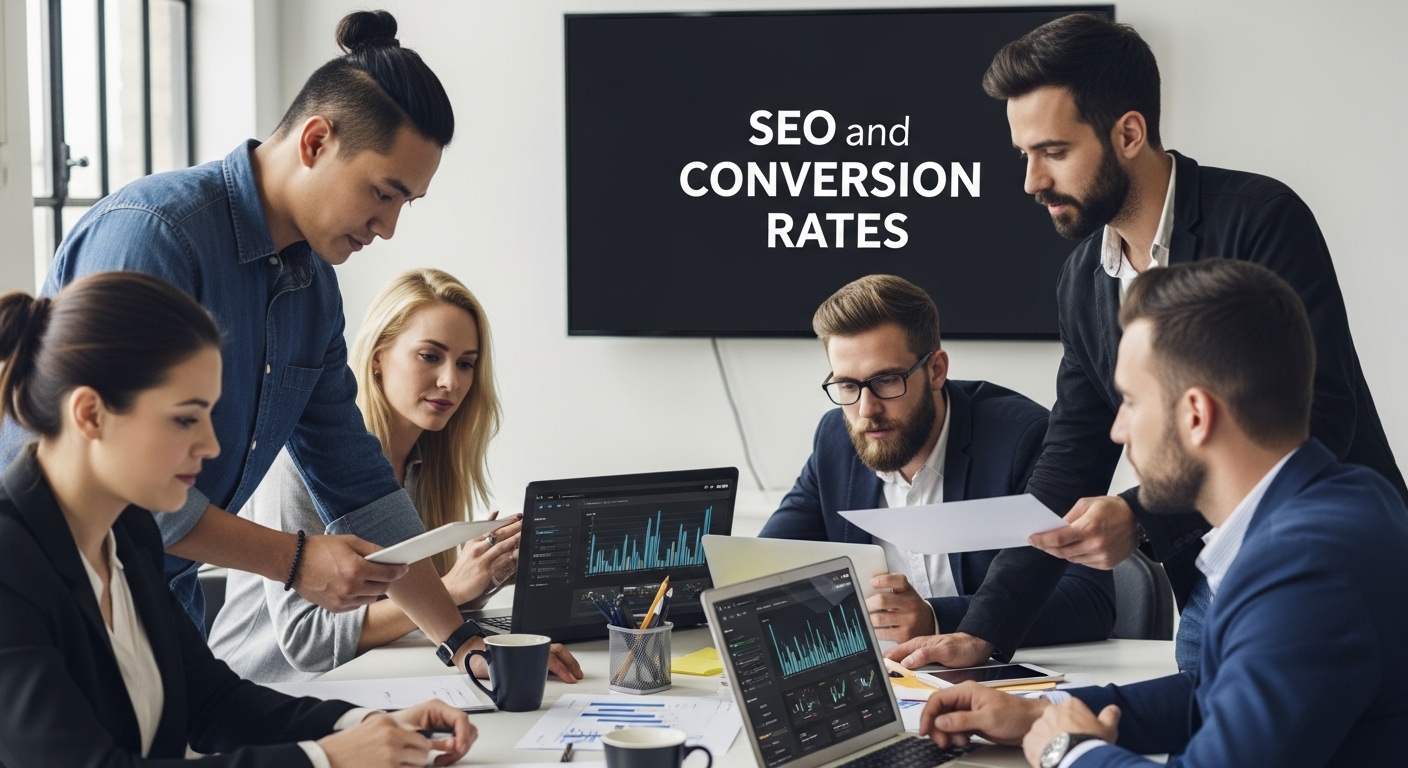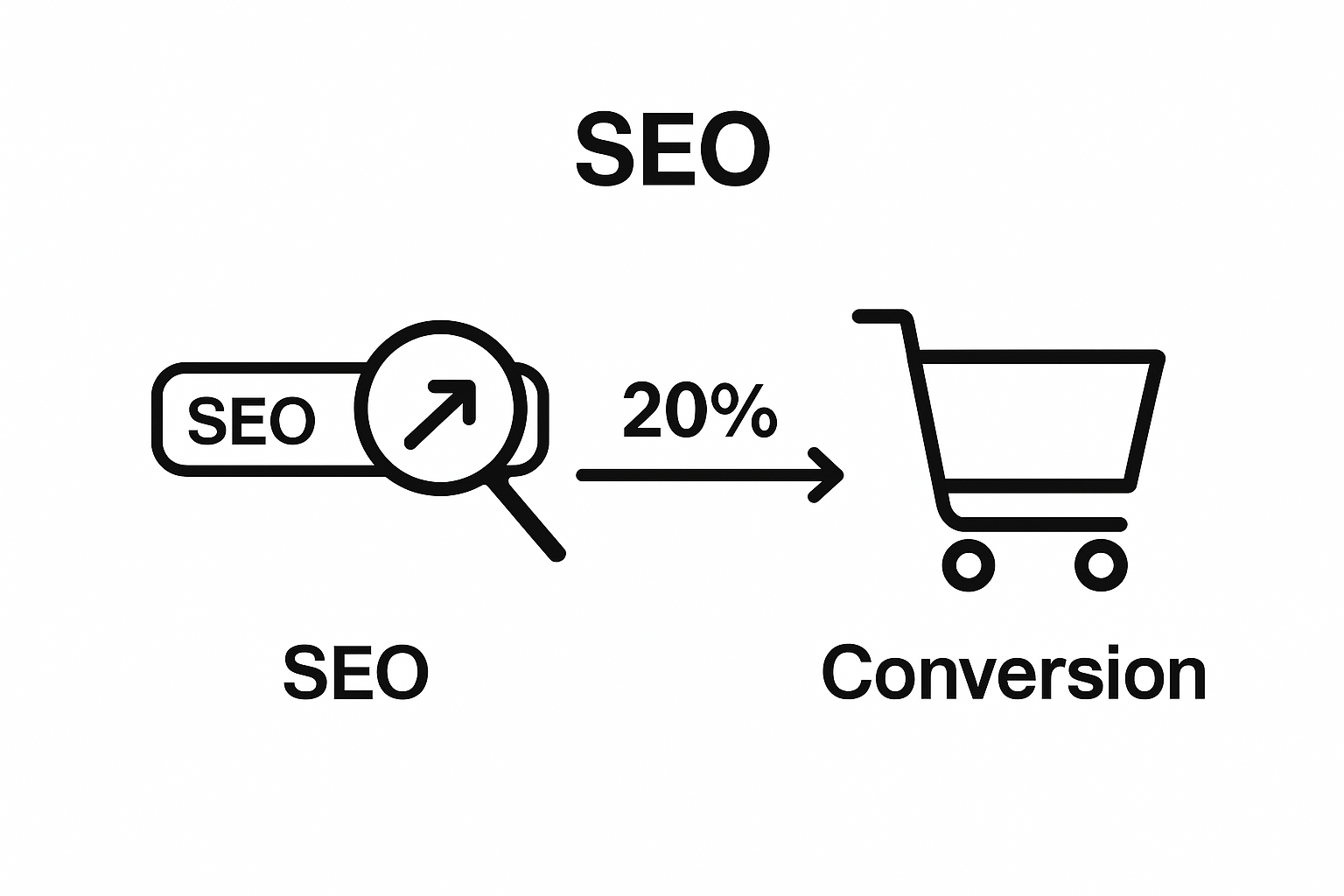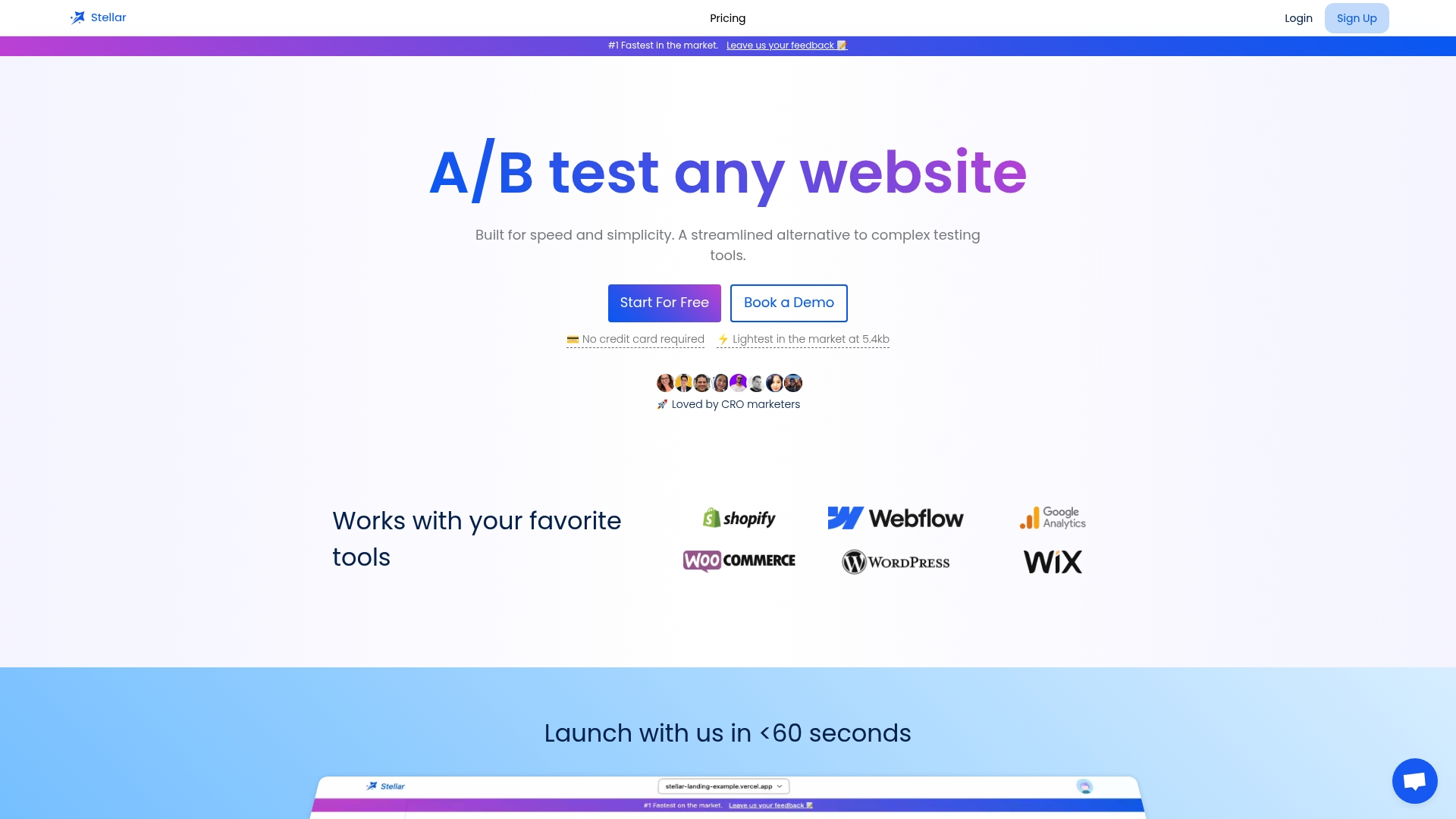
Understanding SEO and Conversion Rates for Growth

SEO and conversion rates are the backbone of every successful website, connecting smart digital strategy with real sales results. Studies show that SEO can generate a return as high as 12.2 times your marketing spend, which sounds massive for such a technical term. But the secret is, these two ideas are more closely linked than most people realize—and the real power comes when you combine them, not just treat them separately.
Table of Contents
- Defining Seo And Conversion Rates: Key Concepts
- The Importance Of Seo In Driving Traffic And Conversions
- How Seo Influences Customer Behavior And Decision Making
- Best Practices For Integrating Seo And Conversion Strategies
- Measuring The Impact Of Seo On Conversion Rates
Quick Summary
| Takeaway | Explanation |
|---|---|
| SEO enhances website visibility. | Improving SEO leads to higher rankings in search results, driving organic traffic to your site. |
| Focus on high-quality content. | Creating relevant, engaging content helps attract the right audience and boosts conversion rates. |
| Optimize for user intent. | Understanding users' search intentions allows businesses to tailor content that meets their needs, increasing engagement. |
| Measure SEO impact on conversions. | Use key performance indicators to track the relationship between SEO efforts and resulting customer actions. |
| Integrate SEO and CRO strategies. | Combining Search Engine Optimization with Conversion Rate Optimization creates a cohesive approach to attracting and converting visitors. |
Defining SEO and Conversion Rates: Key Concepts
Understanding digital marketing requires grasping two fundamental metrics: Search Engine Optimization (SEO) and conversion rates. These interconnected strategies are critical for driving online business growth and measuring marketing effectiveness.
What is Search Engine Optimization (SEO)?
Search Engine Optimization represents a strategic approach to improve a website's visibility in organic search results. According to research from the University of Nebraska-Lincoln, SEO involves optimizing various website elements to rank higher in search engine results pages.
Key components of effective SEO include:
- Keyword optimization
- High-quality content creation
- Technical website performance improvements
- Building authoritative backlinks
Understanding Conversion Rates
Conversion rates measure the percentage of website visitors who complete a desired action. Researchers from the National Institutes of Health define conversion rates as a critical metric for assessing digital marketing success.
These actions might include:
- Purchasing a product
- Signing up for a newsletter
- Completing a contact form
- Downloading a resource
Effective digital marketing strategies aim to simultaneously improve both SEO and conversion rates. By attracting more targeted traffic through optimized search rankings and creating compelling user experiences, businesses can transform website visitors into valuable customers. Learn more about tracking conversions with our comprehensive guide.
Successful marketers understand that SEO and conversion rates are not isolated tactics but interconnected strategies that work together to drive meaningful online growth.
Below is a table summarizing the main components of both SEO and Conversion Rate Optimization (CRO) as described in the article, helping to clarify how these strategies complement each other.
| Strategy | Primary Focus | Key Components | Role in Growth |
|---|---|---|---|
| Search Engine Optimization (SEO) | Improving website visibility in organic search | Keyword optimization, content creation, technical performance, backlinks | Attracts qualified traffic |
| Conversion Rate Optimization (CRO) | Increasing percentage of visitors who convert | Landing page optimization, user experience, A/B testing, call-to-actions | Turns visitors into customers |
| Integrated SEO + CRO | Combining visibility and conversion efforts | Strategic content, seamless user journey, measurement of SEO on conversions | Maximizes online growth |
The Importance of SEO in Driving Traffic and Conversions
Search Engine Optimization (SEO) is not just a technical strategy but a critical business growth mechanism that directly impacts website visibility, user engagement, and ultimately, conversion rates. Organic search traffic represents a significant opportunity for businesses to attract qualified prospects without continuous advertising expenditure.
How SEO Generates Quality Website Traffic
Effective SEO transforms websites from digital billboards into dynamic customer acquisition platforms. Research from Lamar University indicates potential returns on investment as high as 12.2 times marketing spend, demonstrating SEO's powerful economic potential.
Key mechanisms for generating quality traffic include:
- Targeting specific user intent through strategic keyword selection
- Creating high-relevance content matching user search queries
- Improving website technical performance and user experience
- Building authoritative backlinks from reputable websites
Connecting SEO Efforts to Conversion Potential
SEO is not just about attracting visitors but attracting the right kind of visitors. By optimizing content for specific audience segments, businesses can increase the likelihood of converting website traffic into meaningful actions. Check out our guide on boosting ecommerce conversion strategies to understand how targeted traffic translates into sales.
Successful SEO strategies recognize that quality trumps quantity. A well-optimized webpage that precisely matches user search intent will consistently outperform generic, high-traffic pages with low relevance. This targeted approach ensures that every website visitor represents a potential customer more likely to engage with your products or services.
By integrating SEO best practices, businesses can create a sustainable digital marketing ecosystem that continuously attracts, engages, and converts potential customers with minimal recurring advertising costs.
How SEO Influences Customer Behavior and Decision Making
Search Engine Optimization (SEO) profoundly impacts how customers discover, evaluate, and interact with businesses online. By strategically positioning content and understanding user search intent, companies can significantly influence customer decision making processes.
The Psychology of Search Behavior
Customer search journeys are complex psychological pathways that begin with identifying a need and end with making a purchasing decision. Research from an academic study demonstrates how search engine optimization directly interacts with customer relationship management to shape purchasing behaviors.
Key psychological factors influencing search behavior include:
- Establishing trust through high-ranking search results
- Providing immediate answers to specific user queries
- Creating content that addresses customer pain points
- Demonstrating expertise and credibility through informative material
Converting Search Intent into Customer Action
Successful SEO strategies transform search queries into meaningful customer interactions by precisely matching content with user expectations. When websites deliver exactly what searchers seek, they dramatically increase the probability of converting casual browsers into engaged customers. Explore deeper insights into website conversion psychology.
Customers unconsciously use search rankings as a proxy for business credibility. Websites appearing on the first page of search results are perceived as more trustworthy and authoritative, which directly influences their purchasing decisions. This psychological phenomenon means that effective SEO is essentially digital reputation management.
By understanding and strategically addressing customer search behaviors, businesses can create a seamless journey from initial curiosity to confident purchase, leveraging the powerful intersection of technology and human decision making.
Best Practices for Integrating SEO and Conversion Strategies
Successful digital marketing demands a holistic approach that seamlessly integrates Search Engine Optimization (SEO) and Conversion Rate Optimization (CRO). These complementary strategies work together to attract, engage, and transform website visitors into loyal customers.

Creating Content that Converts
Research from the U.S. Department of Energy highlights the critical importance of unique, descriptive page elements in enhancing both user experience and search engine performance. Effective content must simultaneously satisfy search algorithms and human curiosity.
Key elements of conversion-focused content include:
- Addressing specific user pain points and questions
- Using clear, compelling language that drives action
- Structuring information with scannable headings and subheadings
- Incorporating targeted keywords naturally
Technical Optimization for User Experience
The technical backbone of your website plays a crucial role in converting search traffic. Speed, mobile responsiveness, and intuitive navigation are non-negotiable factors that directly impact both SEO rankings and user engagement. Learn more about integrating SEO and conversion testing strategies.
Websites must create a frictionless journey from search result to conversion, which means:
- Minimizing page load times
- Ensuring mobile-friendly design
- Implementing clear, compelling call-to-action buttons
- Reducing unnecessary steps in the conversion funnel
By treating SEO and conversion strategies as interconnected rather than separate disciplines, businesses can create a powerful digital ecosystem that attracts qualified traffic and efficiently transforms visitors into customers. The most successful digital strategies recognize that search visibility is merely the first step in a comprehensive customer acquisition process.
Measuring the Impact of SEO on Conversion Rates
Understanding the tangible relationship between SEO efforts and business outcomes requires sophisticated measurement techniques that go beyond traditional web analytics. Conversion tracking transforms abstract search optimization strategies into concrete performance metrics.
Key Performance Indicators for SEO Conversion Impact
Research from a systematic review demonstrates that strategic SEO implementation can drive up to a 30% increase in website traffic and improve conversion rates by 10% to 25%. Identifying the right metrics is crucial for meaningful analysis.
Essential metrics for measuring SEO conversion impact include:
- Organic search traffic volume
- Conversion rate from organic search
- Average time spent on page
- Bounce rate for organic search visitors
- Revenue generated from organic search channels
Advanced Analytics and Tracking Strategies
Successful conversion measurement requires a holistic approach that connects search behavior with bottom-line results. Check out our comprehensive guide on conversion rate benchmarks to understand industry standards and advanced tracking techniques.
Professional marketers utilize multiple tracking methods to gain comprehensive insights:
- Google Analytics conversion tracking
- Goal funnel visualization
- Multi-channel attribution modeling
- Custom event tracking
- Segmentation of organic search traffic
By implementing robust measurement frameworks, businesses can demonstrate the direct financial impact of SEO strategies, transforming digital marketing from a cost center to a revenue generation engine.
The following table organizes key performance indicators (KPIs) mentioned in the article, summarizing what each measures and why it matters for tracking SEO's impact on conversions.
| KPI | What It Measures | Why It Matters |
|---|---|---|
| Organic search traffic volume | Number of visitors arriving from organic search results | Indicates effectiveness of SEO in attracting users |
| Conversion rate from organic search | Percentage of search visitors completing desired actions | Directly ties SEO efforts to business outcomes |
| Average time spent on page | How long visitors stay on a specific page | Signifies content relevance and engagement |
| Bounce rate for organic search visitors | Percentage leaving after viewing only one page | High bounce rate may signal low content or UX relevance |
| Revenue from organic search channels | Amount generated from search-driven conversions | Demonstrates tangible financial benefit of SEO investments |

Turn SEO Wins Into Real Conversions With Stellar
You have worked hard to boost your SEO and attract targeted traffic. Now you are facing the next challenge: transforming that valuable visibility into actual customer actions. Are you seeing visitors drop off before converting? The article showed how crucial it is to align your landing pages and user experience with both search intent and technical performance. Missed opportunities can happen if your site is slow, hard to edit, or not fully optimized for the user journey you worked so hard to create.

Stellar helps you bridge the gap between higher rankings and greater conversions. With an ultra-fast A/B testing tool and no-code visual editor, you can turn insights from your SEO strategy into proven results—fast. Adjust your landing pages, test dynamic keyword insertion to match user intent, and track every goal in real time. Do not let your new traffic slip away. Get started with the platform trusted by smart marketers and see the difference today at Stellar. If you want to learn more about how our advanced goal tracking and real-time analytics can level up your conversion rates, explore all the details on our homepage.
Frequently Asked Questions
What is SEO and why is it important for businesses?
Search Engine Optimization (SEO) is a strategic approach to improve a website's visibility in organic search results. It is important for businesses as it increases website traffic, engages visitors, and ultimately enhances conversion rates, thereby driving business growth.
How can SEO help improve conversion rates?
SEO helps improve conversion rates by attracting the right kind of visitors to a website through optimized content that matches user intent. When potential customers find exactly what they are looking for, they are more likely to engage and complete desired actions, such as making a purchase or signing up for a newsletter.
What are some key elements of effective SEO strategies?
Key elements of effective SEO strategies include keyword optimization, high-quality content creation, technical website performance improvements, and building authoritative backlinks to enhance a site’s credibility and visibility in search results.
How can businesses measure the impact of SEO on conversion rates?
Businesses can measure the impact of SEO on conversion rates by tracking key performance indicators such as organic search traffic volume, conversion rates from organic search, average time spent on pages, and bounce rates for visitors coming through organic search channels.
Recommended
Published: 9/16/2025